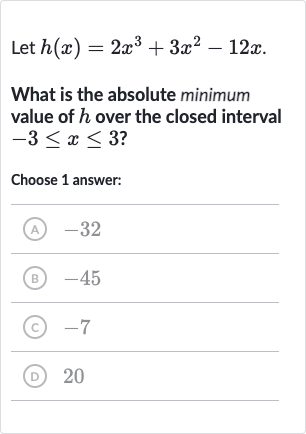Full solution
Q. Let .What is the absolute minimum value of over the closed interval ?Choose answer:(A) (B) (C) (D)
- Calculate Derivative: To find the absolute minimum value of the function over the closed interval , we first need to find the critical points of the function within the interval. Critical points occur where the derivative is zero or undefined. Let's calculate the derivative of .
- Find Critical Points: The derivative of with respect to is . Using the power rule, we get .
- Evaluate Function: Next, we need to find the values of where . Setting the derivative equal to zero gives us the equation . We can simplify this by dividing the entire equation by , resulting in .
- Compare Values: We can factor the quadratic equation to . This gives us two critical points: and .
- Find Absolute Minimum: Now we need to evaluate the function at the critical points and at the endpoints of the interval to find the absolute minimum. The endpoints are and . We will calculate , , , and .
- Find Absolute Minimum: Now we need to evaluate the function at the critical points and at the endpoints of the interval to find the absolute minimum. The endpoints are and . We will calculate , , , and .Evaluating at : .
- Find Absolute Minimum: Now we need to evaluate the function at the critical points and at the endpoints of the interval to find the absolute minimum. The endpoints are and . We will calculate , , , and . Evaluating at : . Evaluating at : .
- Find Absolute Minimum: Now we need to evaluate the function at the critical points and at the endpoints of the interval to find the absolute minimum. The endpoints are and . We will calculate , , , and . Evaluating at : . Evaluating at : . Evaluating at : .
- Find Absolute Minimum: Now we need to evaluate the function at the critical points and at the endpoints of the interval to find the absolute minimum. The endpoints are and . We will calculate , , , and . Evaluating at : . Evaluating at : . Evaluating at : . Evaluating at : .
- Find Absolute Minimum: Now we need to evaluate the function at the critical points and at the endpoints of the interval to find the absolute minimum. The endpoints are and . We will calculate , , , and . Evaluating at : . Evaluating at : . Evaluating at : . Evaluating at : . Comparing the values of at the critical points and endpoints, we find that the smallest value is . Therefore, the absolute minimum value of over the interval is .
More problems from Euler's method
QuestionGet tutor help
QuestionGet tutor help
QuestionGet tutor help
QuestionGet tutor help
QuestionGet tutor help
QuestionGet tutor help
QuestionGet tutor help
QuestionGet tutor help
QuestionGet tutor help

